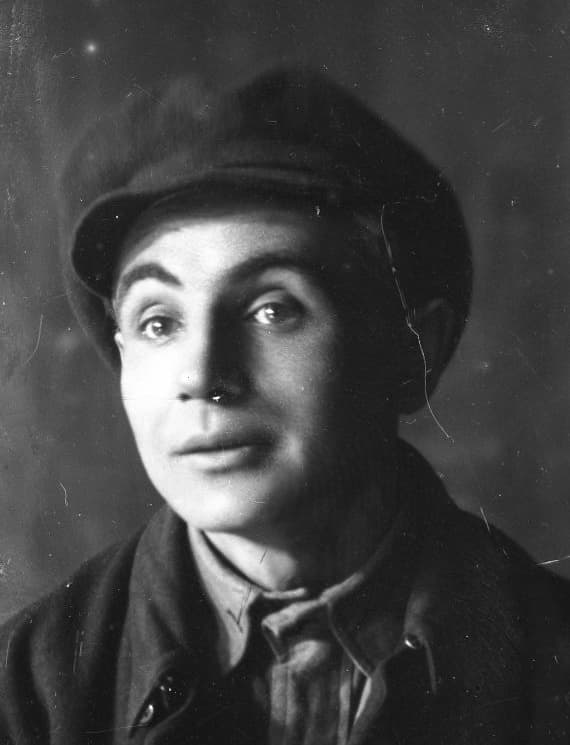by Sophocles
Translated by Ivan Franko
Premiere: November 16, 1918
Director: Les Kurbas
Artist: Anatol Petrytskyi
Oedipus – Les Kurbas
Jocasta, His Wife – Vira Shchepanska
Creon, His Brother – Volodymyr Leontovych
Tiresias, Blind Prophet – Semen Semdor
Priest of Zeus – Marko Tereshchenko
Messenger from Corinth – Yona Shevchenko
Old Shepherd – Hnat Yura
Servant – Volodymyr Kalyn
Chorus:
Women: Antonina Smereka, Halyna Prokhorenko, Antonina Doroshenko, Ryta Neshchadymenko, Olena Rokytianska, Hanna Ihrets, Olha Horodyska, Sofiia Manuilovych
Men: Vasyl Vasylko, Lev Piasetskyi, Oleksandr Yurskyi, Pavlo Dolyna, Stepan Bondarchuk, Favst Lopatynskyi
Les Kurbas was the first to stage Sophocles’ tragedy Oedipus Rex in Ukraine – at the Young Theater. Future Young Theater members had worked on Oedipus Rex in the studio back in May 1916, but it didn’t appear on stage until almost three years later: Kurbas understood that the young actors weren’t ready for that level of drama and had to improve their technique. The actors recalled using a metronome when working on Franko’s translation of Sophocles’ text. They worked on movement and gesture, did breathing exercises, practiced voice control, held group recitations. The actors heard lectures about Ancient Greece during theatrical training, visited museums and libraries, read, and examined paintings and sculptures to discover for themselves the spirit of the ancient times and the mindset of people back then. Director Hnat Yura recalled that the chorus copied poses from ancient vases, frescoes, sculptures, bas-reliefs. Some of the pre-opening rehearsals took place on the beach in Odesa.
In his article “Young Theater. Genesis – Tasks – Directions” Kurbas wrote: “We worked for a long time under very difficult circumstances. But the work was vigorous. There were moments when art seemed to fly quietly over us. There were tears of emotion, bursts of enthusiasm, dread that we were incapable, despair in individuals, competition among the more impatient, petty arguments. But the work continued and the result was more than we expected.”
Kurbas himself created the tragic and powerful image of Oedipus. In this role he moved away from pathetic declamation and tragic expressiveness, which is why, for example, director Hnat Yura and several critics wrote that in the final act he fell into a kind of lyrical everyday tone. But Kurbas did so deliberately: what some critics saw as a negative actually testified to his innovative views and approach to the tragic role.
Critics also applauded Vira Shchepansky in the role of Jocasta, Volodymyr Leontovych as Creon, Semen Semdor as the blind prophet Tiresias, and Hnat Yura as the old shepherd. However, the director had wanted the chorus to be the main character in the performance. Actor Stepan Bondarchuk wrote: “[Kurbas] treated [the chorus] as a kind of collective character that expresses public opinion on things – simply put, the ethical and philosophical ideas of Sophocles himself.” Kurbas worked hard on getting the chorus to move and sound in unison as a single monolithic whole and practiced diction so that every word spoken by the actors reached the audience. His idea about the chorus worked: theater critics, including Dmytro Antonovych, said that the show’s strength wasn’t in the individual performances but in the mass scenes – especially the chorus. Antonovych was struck by the scenes with the chorus: “It was that theatrical set of a classic tragedy that modern theater often doesn’t know what to do with.” In world theater practice, the chorus was sometimes limited to two performers or left out completely. In his article “About Sophocles’ tragedy Oedipus Rex” Kurbas wrote that there would be as many chorus members as there were in ancient Greek theater: 12-14 people. Researchers noted that Kurbas didn’t make the chorus compete with Oedipus: on the contrary, “this wasn’t a brutal blind crowd but a force friendly to Oedipus.” Critic B. Kovdra wrote: “And that is why the tragedy of Oedipus isn’t just a personal tragedy but a tragedy of a large crowd, suffering in their convictions about the truth. Kurbas’s Oedipus Rex is a tragedy of the masses. And, maybe the deliberate transfer of artistic weight from the protagonist to the tragedy’s chorus is the central meaning and modern value of this productions…” “Using the language of ancient classical Greece, the show revealed to the modern audience the eternal ideas of patriotism and greatness of man,” recalled actor Bondarchuk.
Artist Anatol Petrytskyi worked on the show. His set design was simple and laconic, while giving space and air for an epic tragedy. There were ancient columns on the side and back of the stage and an altar in the center of the proscenium. A red curtain decorated with an ancient Greek gold ornament hung between the two middle columns.
Theater critics called Oedipus Rex a new era in the history of Ukrainian theater. Natalia Yermakova, a modern theater critic and researcher of Les Kurbas, notes that “Oedipus Rex becomes the first principal example of national directorial theater.” Actor Valerii Vasyliev recalled that a true pilgrimage to the Young Theater began after the premiere. “There was silence in the hall that united people in a common trembling of the soul,” wrote Stepan Bondarchuk. “There was no rustling or breathing. That’s how the audience reacted to Oedipus Rex on the stage of the Young Theater in 1918.”

